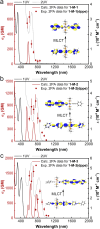Exceptional three- to six-photon absorption at organometallic dendrimers
- PMID: 38873073
- PMCID: PMC11168170
- DOI: 10.1039/d4sc01127a
Exceptional three- to six-photon absorption at organometallic dendrimers
Abstract
The light-intensity dependence of multi-photon absorption (MPA) affords outstanding spatial control. Furthermore, compared to the higher-energy photons needed for analogous linear absorption, the lower-energy photons involved in MPA often correspond to important wavelengths, such as those of the biological and telecommunications "windows". It is therefore of crucial importance to develop molecules that exhibit outstanding MPA cross-sections. However, although progress has been made with two-photon absorption, there is currently a dearth of efficient instantaneous n-photon absorbers (n > 2), a key reason being the scarcity of structure-property studies required to understand higher-order MPA. We herein report systematically-varied metallodendrimers up to third-generation in size, together with their nonlinear absorptive responses over the spectral range 600-2520 nm. We show that the dendrimers exhibit exceptional instantaneous three- to six-photon absorption cross-sections, with maximal values increasing with dendrimer generation and installation of solubilizing group, and we report that changing the groups at the dendrimer periphery can shift the wavelengths of the nPA maxima. We also describe time-dependent DFT studies that have facilitated assignment of the key linear and nonlinear transitions and disclosed the crucial role of the metal in the outstanding MPA performance.
This journal is © The Royal Society of Chemistry.
Conflict of interest statement
There are no conflicts to declare.
Figures





Similar articles
-
Outstanding Multi-Photon Absorption at π-Delocalizable Metallodendrimers.Angew Chem Int Ed Engl. 2022 Mar 1;61(10):e202116181. doi: 10.1002/anie.202116181. Epub 2022 Jan 20. Angew Chem Int Ed Engl. 2022. PMID: 35001474 Free PMC article.
-
Giant Multi-Photon Absorption by Heptazine Organometalation.Angew Chem Int Ed Engl. 2022 Sep 12;61(37):e202208168. doi: 10.1002/anie.202208168. Epub 2022 Jul 19. Angew Chem Int Ed Engl. 2022. PMID: 35778270 Free PMC article.
-
Gigantic two-photon absorption cross sections and strong two-photon excited fluorescence in pyrene core dendrimers with fluorene/carbazole as dendrons and acetylene as linkages.J Phys Chem B. 2010 Sep 16;114(36):11737-45. doi: 10.1021/jp104868j. J Phys Chem B. 2010. PMID: 20735053
-
Two-Photon Absorbing Dendrimers and Their Properties-An Overview.Int J Mol Sci. 2024 Mar 8;25(6):3132. doi: 10.3390/ijms25063132. Int J Mol Sci. 2024. PMID: 38542106 Free PMC article. Review.
-
Fluorescent phosphorus dendrimers excited by two photons: synthesis, two-photon absorption properties and biological uses.Beilstein J Org Chem. 2019 Sep 24;15:2287-2303. doi: 10.3762/bjoc.15.221. eCollection 2019. Beilstein J Org Chem. 2019. PMID: 31598181 Free PMC article. Review.
References
LinkOut - more resources
Full Text Sources

